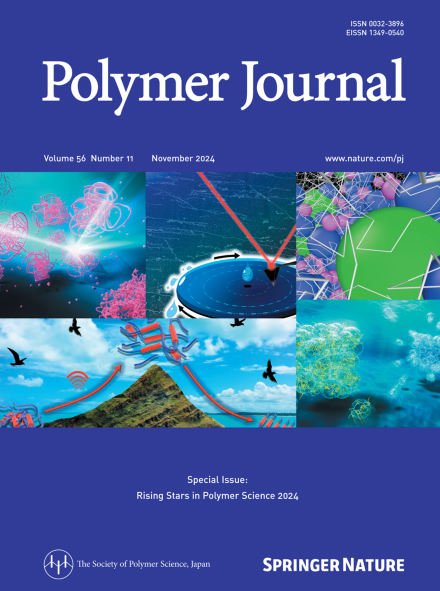水相聚环氧乙烷/二氧化硅纳米颗粒混合物的非线性应力松弛和时间-应变可分离性破坏
IF 2.7
4区 化学
Q3 POLYMER SCIENCE
引用次数: 0
摘要
应力松弛试验是阐明软质材料非线性流变特性的一种有效而简便的方法。对应力松弛行为的深入分析为分子动力学提供了有价值的见解。然而,聚合物/颗粒混合物的应力松弛行为和潜在的分子动力学仍然知之甚少,尽管它们在工业上得到了广泛的应用。在这项研究中,我们系统地研究了结构简单的聚环氧乙烷(PEO)/二氧化硅纳米颗粒水溶液的非线性应力弛豫行为。在高聚合物浓度下观察到时间-应变可分离性,应力松弛归因于聚合物基体的松弛。在较低的聚合物浓度下,时间-应变可分离性不再有效,吸光度随时间的变化表明应力松弛源于聚集结构的松弛。当估计形成粒子间桥的PEO分子数小于1时,观察到从时间-应变可分性到不可分性的转变;这表明剪切加载过程中的结构变化只发生在新的颗粒间聚合物桥形成时,从而导致簇状结构的发展。这些结果提供了对变形和松弛之间关系的基本理解,这对于系统地理解聚合物材料的非线性流变学至关重要。归一化弛豫时间作为估计粒子间聚合物桥(nbridge)数目的函数。图像显示了与nbridge <; 1和1 <; nbridge相关的分子动力学。本文章由计算机程序翻译,如有差异,请以英文原文为准。

Nonlinear stress relaxation and failure of time‒strain separability of aqueous poly(ethylene oxide)/silica nanoparticle mixtures
The stress relaxation test is an effective and facile method for clarifying the nonlinear rheological behavior of soft materials. A thorough analysis of the stress relaxation behavior offers valuable insights into the molecular dynamics. However, the stress relaxation behavior and underlying molecular dynamics of polymer/particle mixtures remain poorly understood, despite their widespread industrial application. In this study, we systematically investigated the nonlinear stress relaxation behavior of a simple-structured poly(ethylene oxide) (PEO)/silica nanoparticle aqueous mixture. Time‒strain separability was observed at high polymer concentrations, with the stress relaxation attributable to the relaxation of the polymer matrix. At lower polymer concentrations, the time‒strain separability was no longer valid, and changes in absorbance over time suggested that stress relaxation originated from the relaxation of the aggregated structures. A transition from time‒strain separability to inseparability was observed when the estimated number of PEO molecules forming interparticle bridges was less than 1; this suggests that structural changes during shear loading occur only when new interparticle polymer bridges are formed, leading to the development of clustered structures. These results provide a basic understanding of the relationship between deformation and relaxation, which is crucial for systematically understanding the nonlinear rheology of polymeric materials. Normalized relaxation time as a function of the estimated number of interparticle polymer bridges (nbridge). Images show the molecular dynamics pertaining to nbridge < 1 and 1 < nbridge.
求助全文
通过发布文献求助,成功后即可免费获取论文全文。
去求助
来源期刊

Polymer Journal
化学-高分子科学
CiteScore
5.60
自引率
7.10%
发文量
131
审稿时长
2.5 months
期刊介绍:
Polymer Journal promotes research from all aspects of polymer science from anywhere in the world and aims to provide an integrated platform for scientific communication that assists the advancement of polymer science and related fields. The journal publishes Original Articles, Notes, Short Communications and Reviews.
Subject areas and topics of particular interest within the journal''s scope include, but are not limited to, those listed below:
Polymer synthesis and reactions
Polymer structures
Physical properties of polymers
Polymer surface and interfaces
Functional polymers
Supramolecular polymers
Self-assembled materials
Biopolymers and bio-related polymer materials
Polymer engineering.
 求助内容:
求助内容: 应助结果提醒方式:
应助结果提醒方式:


